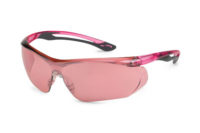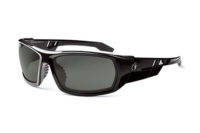Why skip safety glasses?
The one-size-fits-all solution doesn’t work

Captain Obvious says, “Safety glasses only work when worn.” Duh, right? Not so fast.
The U.S. Bureau of Labor Statistics (BLS) estimates that three out of five workers with reported eye injuries were not wearing their safety glasses at the time of injury. And the American Optometric Association (AOA) estimates that there are 2,000 job-related eye injuries every day in the U.S. serious enough to require medical attention, with around 100 of these resulting in lost-time at work.
That’s a whole lotta personal protective equipment (PPE) not being worn and far too many injuries that could’ve easily been prevented.
Why the resistance?
So why are workers so apt to skip their safety glasses? One widely circulated survey cited: “uncomfortable,” “too hot,” “poor fit,” “not available near work task,” and “unattractive looking,” as key factors, right after “did not realize it was needed!”
Glasses are highly personal. Workers’ faces come in all shapes and sizes: what fits one may not fit another. Not to mention that job and task demands vary requiring different types of eye protection. Face shields may be required for grinding tasks to protect the entire face. Splash goggles may be needed for chemical exposures. Welding and foundry work have their own set of special requirements. Still, basic safety glasses remain the most widely-used form of eye protection and are often used in conjunction with other PPE.
The best indication of an effective safety eyewear program is
providing safety glasses that workers want to wear, want to be seen
in, and wouldn't dare be without.
Traditional safety glasses are usually offered as a “one-spectacle-fits-all” solution, based on initial purchase price. They are often unattractive, uncomfortable, and very limited in optical performance. In a worst-case scenario, ill-fitting, scratched, fogged-up, or optically distortive glasses may even contribute to an injury!
A better value can be obtained by selecting proper eyewear based on fit, style, and performance with the goal that workers will choose to wear the glasses and take care of them – saving on injury-related expenses and interruptions. Modern technology and cutting-edge materials allow manufacturers to design high-performance, high-value safety glasses that are safer, lighter, and more comfortable to wear.
Another important factor is compliance and protection. The basis for any modern workplace eye protection is the ANSI Z87.1 American National Standard for Occupational and Educational Eye and Face Protection Devices. This standard includes performance-based testing to demonstrate that the glasses can resist impact from 1) a steel ball projected at 150 feet per second; 2) an 18-oz steel projectile dropped from a height of 50 in; and 3) a weighted needle also dropped from a height of 50 in. Note that the lenses and frames have to be tested together; it does not help if one component resists impact but goes flying off the other. And testing should be done at an independent laboratory or agency to ensure objective, uniform conditions, and reporting.
An even higher level of impact resistance is required to meet requirements of the U.S. Military Combat Eye Protection System (MCEPS). MIL-PRF 34242 Ballistic Impact Fragmentation performance specification for spectacles requires protection from a projectile shot at 660 feet per second – more than four times the impact protection required by the ANSI Z87.1 workplace standard, providing a higher level of employer and worker confidence.
Other hazards
Varied types of indoor lighting, outdoor lighting, and glare require different lens options and solutions while still providing protection from dust, debris, and flying objects.
Tinted, polarized, and mirrored lenses can help reduce glare for bright, outdoor work, and increase worker acceptance. Lenses, even the clear ones, should block 99.9% of harmful UVA, UVB, and UVC rays. Other tints can enhance vision in low light or hazy conditions. Matching the right combination of lenses and lighting can not only reduce eye fatigue, but in some cases, highlight features and improve edge, color, and defect detection, leading to increased productivity.
Workers in hot, humid environments, or workers whose tasks take them between warm and cold areas, such as refrigerated warehouses or air-conditioned offices, know the problem of lens fogging. Newer lens treatments such as permanent anti-fog technology are available that won’t wash, wipe, or wear off, like some temporary coatings, which not only eliminate time consuming work interruptions but protect workers for the life of the product.
Another tricky factor to note: Optical Performance requirements of the ANSI Z87.1 standard require that there are no distracting flat spots in the lenses, which can be an issue with curved lenses. While the right curved lenses provide protection from frontal and many side hazards, some exposures (like wind-driven dust), require a bit more coverage without the need for full goggles. Fixed in place or removable foam gasket inserts not only help to seal the gap between the glasses and workers' faces, reducing debris intrusion, they also allow workers to have only one pair of glasses.
Frames need to do more than just hold the lenses. With styles that gently hug their heads, workers don't have to worry about glasses sliding down sweaty faces, falling off when they look down, or punching themselves in the nose with a greasy glove to keep them on.
Bottom line
No one plans or expects projectiles (like those used in the standards testing) shot at their face. So wearing safety glasses all of the time or keeping them close at hand when needed is an extremely important part of the program. The best indication of an effective safety eyewear program is providing safety glasses that workers want to wear, want to be seen in, and wouldn't dare be without. This exceeds compliance, and becomes part of a culture.
| Resources, references & supplemental materials |
|
Eye and Face Protection eTool OSHA Requirements https://www.osha.gov/SLTC/etools/eyeandface/employer/requirements.html Employees must be trained in the proper care, maintenance, useful life, and disposal of personal protective equipment (PPE). [29 CFR 1910.132(f)(1)(v)]
NIOSH Eye Safety http://www.cdc.gov/niosh/topics/eye/
American Optometric Association Protecting Your Eyes at Work http://www.aoa.org/patients-and-public/caring-for-your-vision/protecting-your-vision?sso=y
The American Academy of Ophthalmology http://www.aao.org/newsroom/release/industrial-workplace-eye-injuries.cfm
Prevent Blindness http://www.preventblindness.org/eye-safety-work http://www.preventblindness.org/ten-ways-prevent-eye-injuries-work http://costofvision.preventblindness.org/
Survey: Workers Risk Injury By Not Wearing PPE
Military Combat Eye Protection (MCEP) Program
P. Johnson patent for ‘Eye Protector’ November 2, 1880. http://www.google.com/patents/US234039
An eye-protector consisting of two sets of |
Looking for a reprint of this article?
From high-res PDFs to custom plaques, order your copy today!




